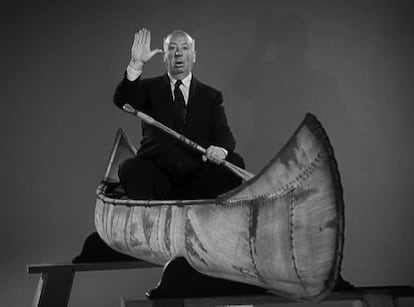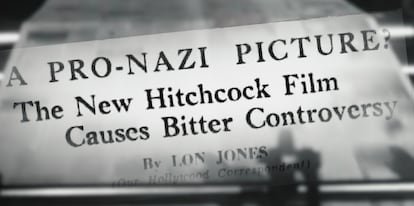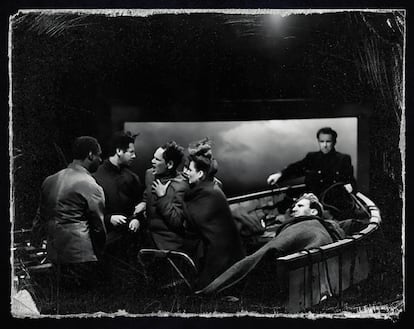Did Hitchcock direct a pro-Nazi movie?
A documentary presented at the Venice Film Festival recalls the controversy of Alfred Hitchcock’s ‘Lifeboat.’ When it was released in 1944 in the midst of World War II, he was accused of using the movie to praise the Germans

Lifeboat doesn’t usually appear on the list of Alfred Hitchcock’s best-known films, although, when it was released in 1944, it sure gave people a lot to talk about. The movie caused a scandal when critics and viewers detected an uncomfortable subtext in its story, which starred nine survivors of a shipwreck in the middle of the ocean. Among them was a German with superhuman traits, which generated anger and misunderstanding in the context of World War II (1939-1945). Now, a French-language documentary titled Le Film Pro-Nazi d’Hitchcock — premiered on September 8 at the Venice Film Festival — delves into the British director’s cursed film, investigating this forgotten controversy.
At the beginning of the 1940s, Hitchcock had just succeeded with his first American film — Rebecca — and had shot two films with the war as a backdrop: Special Agent and Sabotage. He had become popular in Hollywood. Following his much-praised film adaptation of John Steinbeck’s The Grapes of Wrath, Hitchcock had the idea of asking the author to write him an original script with a war theme. This would become the movie Lifeboat.
Steinbeck created an allegory starring eight American and British characters from different social backgrounds. The lead — a capricious reporter — was played by Tallullah Bankhead, who took on the role after a decade away from cinema. The other protagonists included a communist worker, a Black butler, an insufferable businessman and a mother who went mad after the death of her baby, who was still in her arms when she got into the lifeboat.
The cast eventually rescues the captain of a Nazi submarine (the same one that sank their ship). They have no choice but to rely on their survival instincts, as none of them know how to navigate. It was the portrait of the German captain, Willy — who was capable of using a compass, amputating a leg and rowing for days without ever getting tired — that bothered the public. For many, he embodied the physical superiority of the German people.

The first to protest was Steinbeck, who had written the story, although not because of the sticky Nazi question (in 1942, the writer had been criticized for excessively humanizing the Germans in his novel, The Moon Is Down). While he said that that film was “excellent,” he took issue with Hitchcock’s portrayals of the communist and African-American characters. The novelist detested the on-screen caricatures of these men, which, he vowed, didn’t do justice to what he had written.
A generally positive review in The New York Times was among the first to evoke the pro-Nazi subtext. “Clearly, [the film] doesn’t intend to elevate the ideal of a superman… but we suspect that the Nazis, with a few edits, could turn Lifeboat into a whiplash against decadent democracies,” wrote the highly respected film critic Bosley Crowther. “It’s questionable whether such a picture, with such a theme, is judicious at this time.”
Shortly thereafter, Dorothy Thompson — perhaps the most influential American journalist of her day — called for the screening of the film to be suspended, going so far as to call on the FBI to ban it. 20th Century Fox — concerned about the protest letters it kept receiving — decided to limit the number of screenings in the United States and reduce the promotional campaign to a minimum. However, this didn’t prevent Lifeboat from getting three Oscar nominations, including one for Hitchcock as director and one for Steinbeck as screenwriter.
By then, the author of East of Eden and Of Mice and Men had unsuccessfully asked Fox to withdraw his name from the project.
The recently-premiered documentary by Daphné Baïwir, a 31-year-old Belgian director, refutes the pro-Nazi reading of Lifeboat, but also explains why such an interpretation isn’t completely unreasonable. “Hitchcock didn’t want to make a pro-German film, but we can understand the criticism. Perhaps he didn’t know how to defend himself forcefully enough, which ended up causing a kind of snowball effect against the film,” Baïwir opines. In reality, his desire wasn’t to exhibit his (non-existent) Nazi allegiances, but to issue a warning to the allies.
“At that time, there were two forces facing each other: the democracies and the Nazis. While the democracies were totally disorganized, all Germans were moving in the same direction,” Hitchcock explained in his book of interviews with François Truffaut, published in 1966. “The intention was to say that these democracies should put aside their differences and join forces to focus on the common enemy.”
In reality, this German captain in Lifeboat isn’t exactly a model of virtue. He lies to his companions, denies them their water supplies, and changes course to sneakily inch them towards another Nazi ship. He also consumes vitamins so that he can row tirelessly, while the others are exhausted. “It would have been better if Hitchcock had made it clear that, in reality, the vitamins were drugs, but the censorship of the time wouldn’t have allowed it,” Baïwir notes. The providential man who appears at the beginning of the film is revealed to be an impostor: the Nazi is actually on steroids. The eight characters will end up sacrificing him — in a terrible scene that Hitchcock filmed from afar — with his executioners turned away and behaving “like a pack of hounds,” as he admitted to Truffaut. The British director was trying to say that, to defeat the Nazis, the Allies would have to stain their hands with blood.

Hitchcock defended himself poorly when he was accused — or not at all. He tiptoed over this thorny chapter of his career, so it’s not hard to deduce that it left a traumatic mark on him. Right after the film was released, Hitchcock agreed to shoot two propaganda shorts for the British Ministry of Information — Bon Voyage and Aventure Malgache — about the French Resistance. To film them, he returned to Europe, while the bombs were falling. “I felt the need to contribute to the war effort… I was too fat and old to do military service,” he joked. “I knew that, if I didn’t do anything, I would always regret it.”
In 1945, Hitchcock agreed to advise Sidney Bernstein — a childhood friend and future media mogul, who was then at the helm of British propaganda — during the editing of a documentary film about the Bergen-Belsen concentration camp, which used a handful of real footage. He advised using long, naturalistic shots to reinforce the feeling that these terrible images were real and not a cinematographic invention. Hitchcock declared that this esthetic would prevail in the postwar period, during the years of Italian neorealism.

Despite its dismal reputation, Lifeboat is one of Hitchcock’s most daring and challenging films: all the action takes place on the ship, without tricky flashbacks. The music is made conspicuous by its absence: the only soundtrack is the waves of the sea, the wind and the rain — a very unusual choice at that time. Additionally, Lifeboat also contains some themes that would go on to become classics in Hitchcock’s cinema, such as the claustrophobia surrounding the cast, or the notion of seemingly-unbeatable villains, who the heroes end up defeating in the end. In fact, Lifeboat is also one of the best early examples of the survival subgenre, where privileged characters learn to survive and value what’s important in life. We can think of a modern-day Lost.
Finally, the controversy surrounding Lifeboat heralds the censorship of works of art that, by the 1950s, would be imposed in the form of McCarthyism. During this era, when the Wisconsin senator held his infamous hearings, a film was only considered acceptable if it unambiguously exhibited its patriotism and moral virtue. A situation that, according to Baïwir, continues to this day:
“In contemporary, mainstream American cinema, any project must have a positive message and avoid gray areas at all costs,” the director affirms. “Lifeboat is a precedent for the cancel culture that we’re witnessing today.”
Sign up for our weekly newsletter to get more English-language news coverage from EL PAÍS USA Edition
Tu suscripción se está usando en otro dispositivo
¿Quieres añadir otro usuario a tu suscripción?
Si continúas leyendo en este dispositivo, no se podrá leer en el otro.
FlechaTu suscripción se está usando en otro dispositivo y solo puedes acceder a EL PAÍS desde un dispositivo a la vez.
Si quieres compartir tu cuenta, cambia tu suscripción a la modalidad Premium, así podrás añadir otro usuario. Cada uno accederá con su propia cuenta de email, lo que os permitirá personalizar vuestra experiencia en EL PAÍS.
¿Tienes una suscripción de empresa? Accede aquí para contratar más cuentas.
En el caso de no saber quién está usando tu cuenta, te recomendamos cambiar tu contraseña aquí.
Si decides continuar compartiendo tu cuenta, este mensaje se mostrará en tu dispositivo y en el de la otra persona que está usando tu cuenta de forma indefinida, afectando a tu experiencia de lectura. Puedes consultar aquí los términos y condiciones de la suscripción digital.
More information
Archived In
Últimas noticias
Most viewed
- Sinaloa Cartel war is taking its toll on Los Chapitos
- Oona Chaplin: ‘I told James Cameron that I was living in a treehouse and starting a permaculture project with a friend’
- Reinhard Genzel, Nobel laureate in physics: ‘One-minute videos will never give you the truth’
- Why the price of coffee has skyrocketed: from Brazilian plantations to specialty coffee houses
- Silver prices are going crazy: This is what’s fueling the rally











































